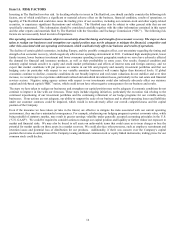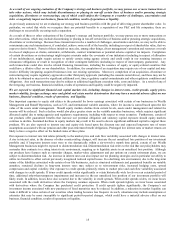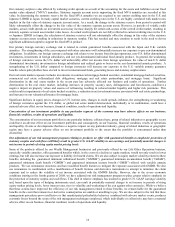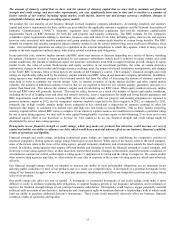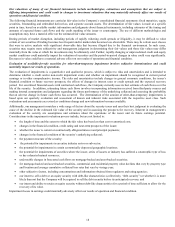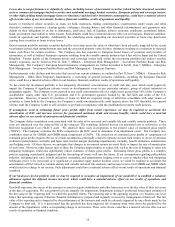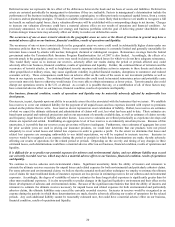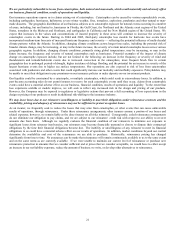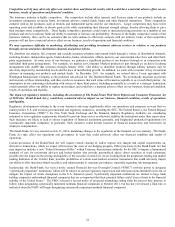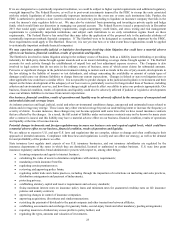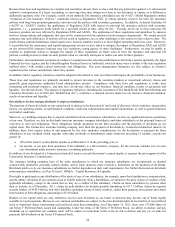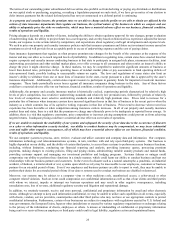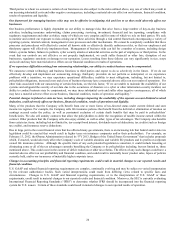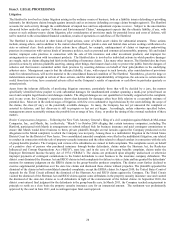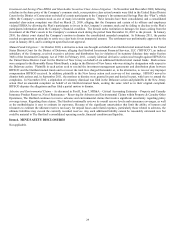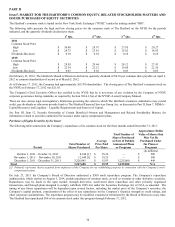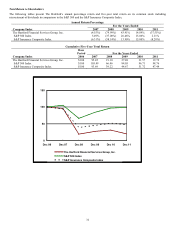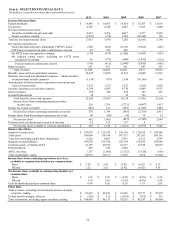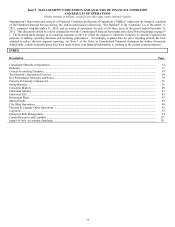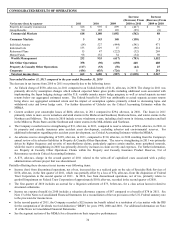The Hartford 2011 Annual Report Download - page 24
Download and view the complete annual report
Please find page 24 of the 2011 The Hartford annual report below. You can navigate through the pages in the report by either clicking on the pages listed below, or by using the keyword search tool below to find specific information within the annual report.
24
Because these laws and regulations are complex and sometimes inexact, there is also a risk that any particular regulator’ s or enforcement
authority’ s interpretation of a legal, accounting, or reserving issue may change over time to our detriment, or expose us to different or
additional regulatory risks. For example, certain of our domestic life insurance subsidiaries use the NAIC’ s Model Regulation entitled
“Valuation of Life Insurance Policies,” commonly known as Regulation XXX, in setting statutory reserves for term life insurance
policies with long-term premium guarantees and universal life policies with secondary guarantees. In addition, Actuarial Guideline 38
(“AG38” or “AXXX”) clarifies the application of Regulation XXX with respect to universal life insurance policies with secondary
guarantees, i.e., a guaranteed death benefit for a specified period of time, often for life. Virtually all of our in force universal life
insurance products are now affected by Regulation XXX and AXXX. The application of these regulations and guidelines by insurers
involves interpretations and judgments that may not be consistent with the opinion of state insurance departments. We cannot provide
assurance that such differences of opinion will not result in regulatory, tax or other challenges to the actions we have taken to date. The
result of those potential challenges could require us to increase statutory reserves or incur higher operating and/or tax costs. Moreover,
it is possible that the reinsurance and capital management actions we have taken to mitigate the impact of Regulation XXX and AXXX
on our universal life insurance business may face regulatory, rating agency or other challenges. Furthermore, we may be unable to
continue to implement actions to mitigate the impact of these regulations on future sales of term life insurance and universal life
policies, resulting in lower returns on such products than we currently anticipate or reduce our sales of these products.
Furthermore, our international operations are subject to regulation in the relevant jurisdictions in which they operate (primarily the Japan
Financial Services Agency and the United Kingdom Financial Services Authority), which in many ways is similar to the state regulation
outlined above, with similar related restrictions and obligations. Our asset management businesses are also subject to extensive
regulation in the various jurisdictions where they operate.
In addition, future regulatory initiatives could be adopted at the federal or state level that could impact the profitability of our businesses.
These laws and regulations are primarily intended to protect investors in the securities markets or investment advisory clients and
generally grant supervisory authorities broad administrative powers. Compliance with these laws and regulations is costly, time
consuming and personnel intensive, and may have an adverse effect on our business, financial condition, results of operations and
liquidity. See the risk factor, “The impact of regulatory initiatives, including the enactment of The Dodd-Frank Wall Street Reform and
Consumer Protection Act of 2010 (the “Dodd-Frank Act”), could have a material adverse impact on our business, financial condition,
results of operations and liquidity.”
Our ability to declare and pay dividends is subject to limitations.
The payment of future dividends on our capital stock is subject to the discretion of our board of directors, which considers, among other
factors, our operating results, overall financial condition, credit-risk considerations and capital requirements, as well as general business
and market conditions.
Moreover, as a holding company that is separate and distinct from our insurance subsidiaries, we have no significant business operations
of our own. Therefore, we rely on dividends from our insurance company subsidiaries and other subsidiaries as the principal source of
cash flow to meet our obligations. These obligations include payments on our debt securities and the payment of dividends on our
capital stock. The Connecticut insurance holding company laws limit the payment of dividends by Connecticut-domiciled insurers. In
addition, these laws require notice to and approval by the state insurance commissioner for the declaration or payment by those
subsidiaries of any dividend which, together with other dividends or distributions made within the preceding 12 months, exceeds the
greater of:
• 10% of the insurer’ s policyholder surplus as of December 31 of the preceding year, or
• net income, or net gain from operations if the subsidiary is a life insurance company, for the previous calendar year, in each
case determined under statutory insurance accounting principles.
In addition, if any dividend of a Connecticut-domiciled insurer exceeds the insurer’ s earned surplus, it requires the prior approval of the
Connecticut Insurance Commissioner.
The insurance holding company laws of the other jurisdictions in which our insurance subsidiaries are incorporated, or deemed
commercially domiciled, generally contain similar, and in some instances more restrictive, limitations on the payment of dividends.
Dividends paid to us by our insurance subsidiaries are further dependent on their cash requirements. For further discussion on dividends
from insurance subsidiaries, see Part II, Item 7, MD&A – Capital Resources & Liquidity.
Our rights to participate in any distribution of the assets of any of our subsidiaries, for example, upon their liquidation or reorganization,
and the ability of holders of our common stock to benefit indirectly from a distribution, are subject to the prior claims of creditors of the
applicable subsidiary, except to the extent that we may be a creditor of that subsidiary. Claims on these subsidiaries by persons other
than us include, as of December, 2011, claims by policyholders for benefits payable amounting to $117.1 billion, claims by separate
account holders of $143.9 billion, and other liabilities including claims of trade creditors, claims from guaranty associations and claims
from holders of debt obligations, amounting to $13.0 billion.
Holders of our capital stock are only entitled to receive such dividends as our board of directors may declare out of funds legally
available for such payments. Moreover, our common stockholders are subject to the prior dividend rights of any holders of our preferred
stock or depositary shares representing such preferred stock then outstanding. As of December 31, 2011, there were 575,000 shares of
our Series F Preferred Stock issued and outstanding. Under the terms of the Series F Preferred Stock, our ability to declare and pay
dividends on or repurchase our common stock will be subject to restrictions in the event we fail to declare and pay (or set aside for
payment) full dividends on the Series F Preferred Stock.


